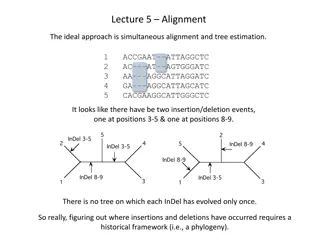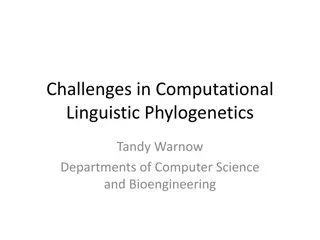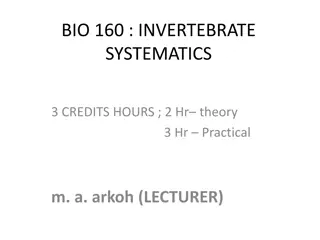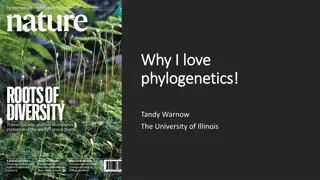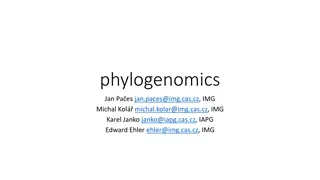Progressive Alignment Overview in Phylogenetics
In the field of phylogenetics, the process of progressive alignment is crucial for aligning sequences and building evolutionary trees. This approach involves generating pairwise alignments, estimating distances, constructing guide trees, and aligning sequences progressively based on the tree. Needle
0 views • 12 slides
Computing Triplet and Quartet Distances Between Evolutionary Trees
Study on computing triplet and quartet distances in evolutionary trees, comparing rooted vs. unrooted, binary vs. arbitrary degree trees. Discusses algorithms, experimental results, and evolutionary tree construction methods. Includes analysis on cultural phylogenetics and evolutionary tree comparis
0 views • 27 slides
Enhancing Phylogenetic Analysis Using Divide-and-Conquer Methods
Large-scale phylogenetics presents challenges due to NP-hardness and dataset sizes. Divide-and-conquer methods like SATe, PASTA, and MAGUS enable efficient processing of large datasets by dividing, aligning, and merging subsets with accuracy. MAGUS, a variant of PASTA, utilizes a unique alignment me
0 views • 15 slides
Unrooted Trees in Phylogenetics
Explore the concept of unrooted trees in phylogenetics, including Newick strings, induced quartet trees, and representations. Learn about the importance of drawing rooted and unrooted trees, as well as understanding the relationship between unrooted trees and binary rooted evolutionary trees.
2 views • 63 slides
Challenges in Computational Linguistic Phylogenetics
This article delves into the challenges and controversies surrounding Indo-European language history, including discussions on subgrouping, the IE homeland, and the life of proto-Indo-European speakers. It explores hypotheses such as the Anatolian and Kurgan theories, estimating dates and homelands
1 views • 51 slides
Phylogenetic Analysis and Tree Terminology
Phylogenetics is the study of evolutionary history using tree diagrams to represent organism pedigrees. Analyzing fossil records, molecular data, DNA sequence evolution, and tree terminology play crucial roles. Understanding dichotomy vs. polytomy, rooted vs. unrooted trees, and the challenges of fi
1 views • 54 slides
Methods of illustrating evolutionary relationship
Systematics involves grouping and determining the relationships among organisms through Taxonomy and Phylogenetics. Taxonomy focuses on classifying and naming organisms, while Phylogenetics studies evolutionary relationships. Evolutionary trees, sister taxa, clades, monophyletic and paraphyletic gro
0 views • 6 slides
Addressing Sequencing Errors in Phylogenetics
The impact of sequencing errors on phylogenetic analysis and the strategies to mitigate these errors through probabilistic modeling and next-generation sequencing technologies. This research delves into gene evolution, convergent evolution, mutation rate variation, and divergence time estimation in
0 views • 20 slides
Invertebrate Systematics - Study of Biological Diversity and Relationships
Delve into the world of invertebrate systematics, exploring the diversity and inter-relationships of living organisms through time. This course covers the phylogenetics of invertebrates, taxonomy, and the classification of various sub-kingdoms within the animal kingdom. Understand the historical and
0 views • 12 slides
Phylogenetic Inference and DNA Evolution: Understanding the Tree of Life
Discover the fascinating world of phylogenetics, evolutionary trees, and DNA sequence evolution through the lens of mathematical models and statistical inference methods. Explore how phylogenetic analysis helps unravel the relationships between species over millions of years, guided by experts like
0 views • 10 slides
Understanding UPGMA Phenetic Clustering in Phylogenetics
Explore the UPGMA algorithm for phenetic clustering in phylogenetics, discussing its steps and application in estimating phylogenetic trees. Discover how UPGMA constructs composite taxa and generates new distance matrices to create a representative tree. Learn about the assumptions and limitations o
1 views • 21 slides
Understanding Phylogenomics and Phylogenetic Analysis
Explore the significance of phylogenetics, its applications in deducing relationships among species or genes, identifying genes undergoing selection, tracing trait evolution, and estimating historical timelines. Learn about the basic assumptions, terminology, tree representations, and testing topolo
0 views • 36 slides
Addressing Sequencing Errors in Phylogenetics: Insights and Solutions
Explore the impact of sequencing errors on phylogenetic analysis and how to mitigate them through probabilistic modeling and incorporating next-generation sequencing data. Learn about error-prone areas, gene evolution, mutation rates, and divergence time estimation in the context of evolutionary stu
0 views • 20 slides
